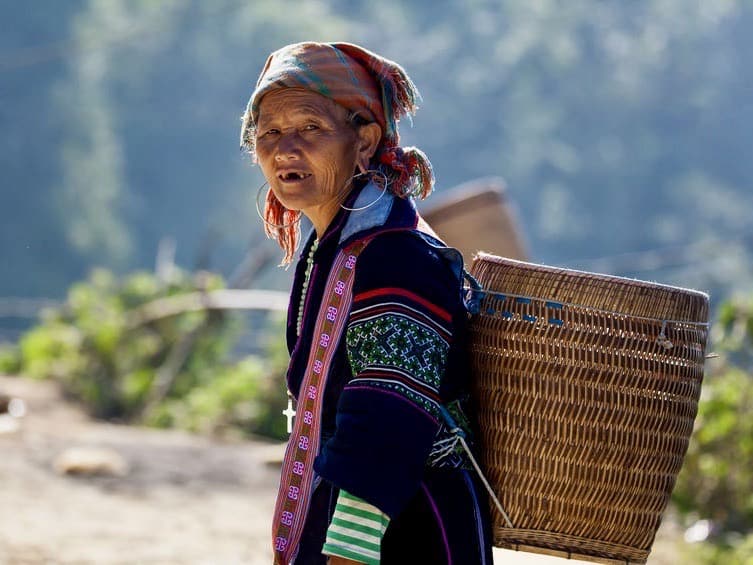The Hmong, which means free, is a very independent ethnic group around Asia; the Hmong have a vibrant and exciting history. Their history and culture have now become intertwined with the country and places where they are presently living.
The Hmong originally came from China, but during the late 18th Century, the Qing Dynasty started to push them out of China into many Chinese border areas. Today many Hmong live in the countries along the southern Chinese border. There are many ethnic groups of Hmong. Most of the Hmong are farmers though many have recently started to be involved in the tourism industry.
Table of Contents
- Hmong History
- The population of the Hmong
- The Vietnamese Hmong society today
- The Hmong and Farming
- Hmong and tourism
- Frequently Asked Question
- Related Content
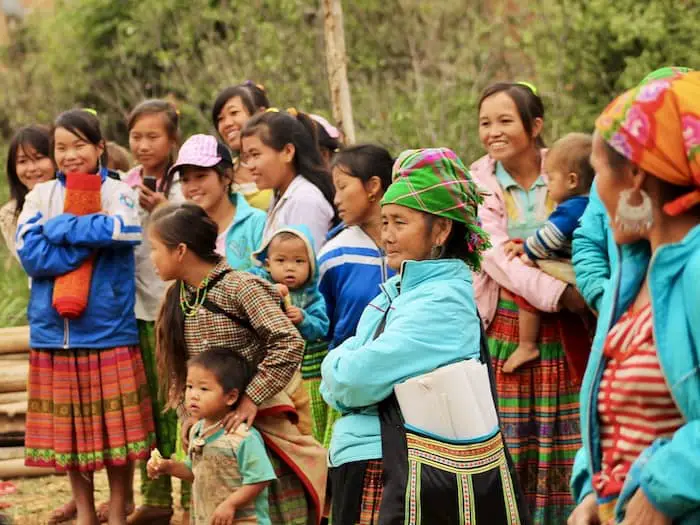
Hmong History
The Hmong, also known as Miao, is an ethnic group that lives in China, Vietnam, Laos, Myanmar, and Thailand. Since the Vietnam War, many Hmong have also immigrated to the United States, France, Australia, and Canada.
Learning Hmong history has also been difficult as the Hmong handed down their history orally; Hmong was never a written language, though there is a written one today. Even today, many Hmong can only speak and not read or write the Hmong language.
The Hmong history is entirely oral, so history has been left up to the older people’s memories and what they remember or do not remember. This means having an exact Hmong history has been difficult to find or discover.
But despite this lack of written history, we know a few things about the Hmong. Most scholars agree that Hmong is a minority group from China and traveled out of China to reside in the southern border areas around China.
In the late 18th Century, many Hmong were pushed out of the Yellow River basin in ‘China, where they settled. As China’s population grew, the Hmong people were forced more to the border areas between China and Vietnam, Laos, Thailand, and Myanmar. Those that did not leave were persecuted or killed by the Qing Dynasty, the government of China.
Though the Hmong had no political affiliations, they were in open conflict with the Qing Dynasty, the Chinese government of China at the time. This led to the Hmong mass persecution within China, forcing many of the Hmong to leave their homes in China and settle in China’s border areas.
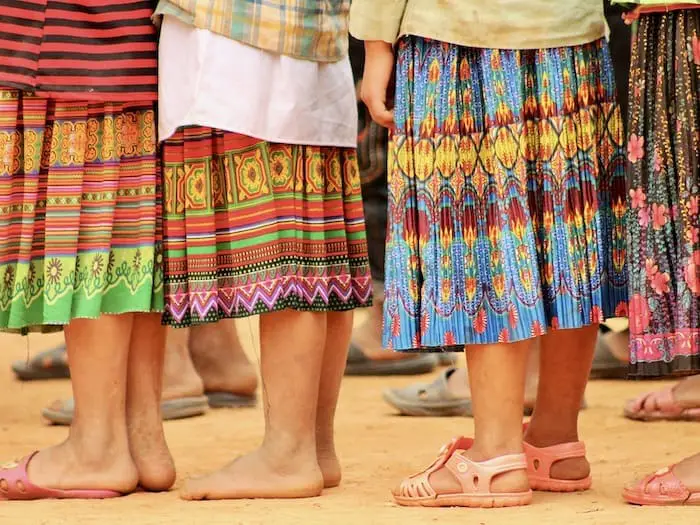
Dr. Kim Lacy Rogers, a professor of History and American Studies at Dickinson College and one of the most noted oral Hmong historians in the United States, researched the Hmong. Dr. Kim Lacy Rogers wrote:
“In the eighteenth, and nineteenth centuries, while the Hmong lived in south-western China, their Manchu overlords had labeled them “Miao” (‘barbarian’ or ‘savage’) and targeted them for genocide when they defied being humiliated, oppressed and enslaved.”
DR KIM LACY ROGERS
The Chinese grouped several ethnic minorities and called them all Miao. So in China, Miao does not necessarily mean that the group they are referring to is Hmong; the Miao be entirely another ethnic group that the Chinese also call Miao.
But for many Hmong, their oppression did not stop once they left China. In many areas where the Colonial French were in power, the French government also imposed great hardship on them in the form of fines, taxation, and forced labor.
The Hmong King – Chi You
The Hmong are said to have a King named Chi You. This King came from the ancient Chinese town of Zhuolu in northwestern Hebei province. To give you some perspective, this town is about 149 kilometers north of present-day Beijing.
Today if you travel to the ancient town of Zhuolu, you can find a statue of King Chi You. The Hmong people believe that he was their King and that they are descendants of him.
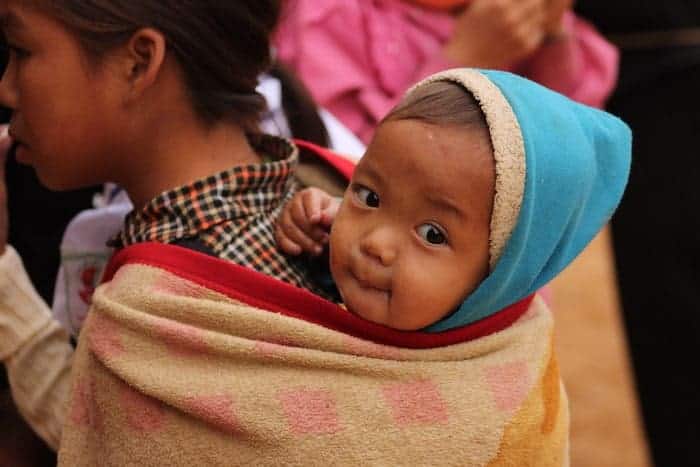
The population of the Hmong
There are about 4 to 6 million Hmong in the world. The population of the Hmong can be broken down as follows:
| Country | Estimated Hmong Population |
| China | Over 2,500,000 |
| Vietnam | Over 1,000,000 |
| Laos | Over 500,000 |
| The United States | Over 260.000 |
| Thailand | Over 250,000 |
| Myanmar (Burma) | Over 10,000 |
| Australia | Over 2,100 |
| France | Over 2,000 |
As you can see from this chart many of the Hmong still live in China, with Vietnam being the country with the second-largest population of Hmong. For this reason, we can say that in the present day, most of the Hmong live in Vietnam and China.
Vietnamese Hmong
In the late 18th century, as the Hmong were pushed out of China’s Yellow River basin, they settled in the border areas of Vietnam, Laos, Thailand, and Myanmar. Many of the Hmong settled in Vietnam. This could be because Vietnam was closer to its homeland in China, and the culture and landscape would have been very similar.
But once again, with the French and the Vietnamese fighting in Vietnam, the Hmong had to choose which side they would be on for this new conflict. Maybe it was in part because the French had caused many of the Hmong to suffer so much, so when the Viet Minh started to fight the French forces for the liberation of Vietnam from French Colonial rule, many of the Hmong in North Vietnam joined in the fight to fight against the French.
There were some Vietnamese Christian Hmong who decided to side with the French. When the French left Vietnam for good, most of these groups were also forced to leave their homeland as they fled to South Vietnam. So, even among the Hmong themselves, not every group and every community were on the same side of the war.
Because of their political associations, many of the Hmong groups have suffered over the years. Since leaving China, they are a group of people who have often been forced to choose which side of the conflict they would be on.
Hmong in Laos
Perhaps there is no other country where the Hmong made this choice as to what side of the conflict they would be on than the Hmong living in Laos. These groups of Hmong took on a very different role than their relatives on the other side of the Vietnamese border.
In the early 1960s, the U.S Central Intelligence Agency (CIA) began actively recruiting, training, and organizing the Hmong people in Laos to fight against the North Vietnamese army fighting a war with the Americans. This was known to be a “secret army” of Hmong Laotian soldiers that General Vang Pao led.
Over 60% of all Hmong men were estimated to join this army. This secret army helped the American soldiers in many ways, from fighting the Nothern Vietnamese to going into North Vietnam to rescue downed American pilots. Undoubtedly, the Hmong made great sacrifices to help the U.S. Army during this conflict.
I have a friend whose father was one of these Hmong soldiers. In his home village, he told me that the Americans had set up a radar system in the village for American airplanes. The village’s role was to help control the American pilots’ radar and guide the pilots back to safety.
When the war ended and the Americans left North Vietnam, his family had to leave their home village. He was born out in the Laotian jungle, and it took his parents several years to make their escape from Laos.
They had to be careful not to be found and then killed, so his mother would give him opium so he would not cry. By the time he had come to the United States as a small baby, he was addicted to opium.
The different Hmong groups
In Vietnam and Laos, not all the Hmong are the same group. Each Hmong group can have different cultures, festivals, and traditions. Some also have different religions, with some groups being Christian-based.
Some of the more common Hmong groups:
- Black Hmong (Hmoob Dub or Hmong Dou)
- Striped Hmong (Hmoob Txaj or Hmoob Quas Npab)
- Hmong Shi
- Hmong Phi
- Hmong Pua
- Hmong Xau
- Hmong Xanh (Green Hmong)
- Hmong Do (Red Hmong)
- Na Miao
- Flower Hmong
- Variegated Hmong (Hmong Lenh or Hmong Hoa)
Many of these groups will dress in their traditional clothes, which will be the color of the group they represent. They will live in communities according to their groups.
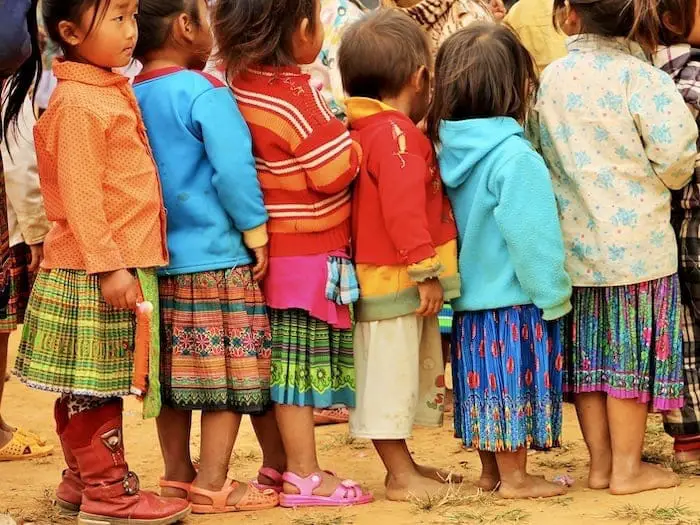
The Vietnamese Hmong society today
Many of the Hmong are suffering today and being left behind in the current society. There are many reasons for this, but largely, it is a circumstance of education and where they live.
Today, in North Vietnam, many Hmong children may need to walk over 10 miles through the mountain paths to attend the nearest school. For many of these same children to stay in school past the 2nd or 3rd grade, they may need to spend their weeks at the school in a dorm and only be home on the weekends.
Because of this extreme hardship, many Hmong parents may choose not to send their children to school. Many of the younger girls may need to stay home from school to help take care of younger siblings while their parents work out in the fields. This lack of education, of course, adds to the Hmong’s poverty in Vietnam, making it difficult for many of them to get a good education and get out of poverty.
In the mountain areas, many Hmong live as they did for hundreds of years. It is not uncommon for a Hmong girl to marry at a very young age, such as 13, 14, or 15. The father would often be about the same age or just a bit older. It can be a bit like children trying to raise their children.
These young marriages can perpetuate poverty, as many Hmong will have large families. And they may feel like their children should also get married when they are young, just like they did.
Especially in many border areas, Hmong girls have either been forced or have willingly gone to a place like China to be wives for Chinese men or work in the sex trade. Many groups in Vietnam, including the government, are working hard to stop these social problems. But it can be challenging when many of the Hmong lack education and may feel that life over the border would be easier than at home.
The Hmong and Farming
The Hmong have always been farmers. But as they have been pushed about so much, they have been pushed into the mountain areas and land.
Traveling to North Vietnam, you can see their houses dotted with mountain areas. The Hmong do this kind of farming on the mountainsides, which is tough and challenging. They are usually growing corn on the mountains for pig feed. As this is grown on the mountainside, no machinery can be used, and it must all be done by hand.
When they cut down the trees, and some heavy rains, land erosion and mass flooding can occur. The farming life for the Hmong today is not easy.
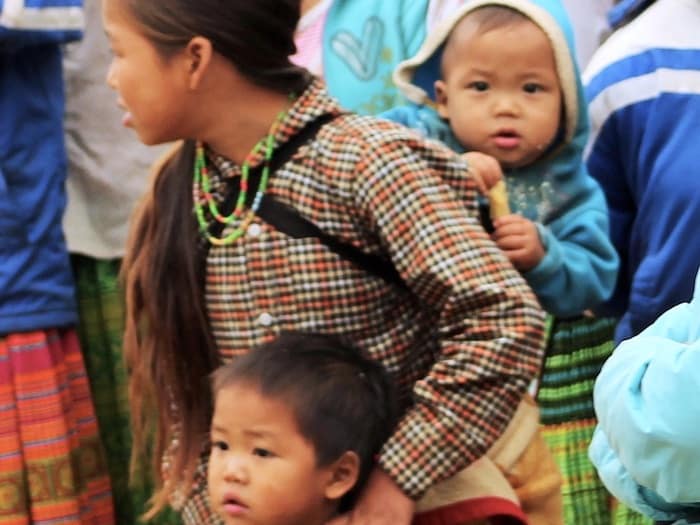
Hmong and tourism
In many parts of North Vietnam, the Hmong have stopped farming as their primary income and started working in the tourism industry instead. Many young Hmong are working as tour guides. Other Hmong are at the local markets selling some of their wares to the tourist who comes through.
Some Hmong will rent their Hmong-style houses for foreigners to stay the night in as a homestay. Others will cook Hmong food for foreign guests or teach them to make some batik cloth.
This means that many Hmong in the tourist areas has stopped living their traditional lifestyles except to show this life to foreigners as a part of tourism.
The Hmong have a vibrant history, tradition, and culture that they continue to pass down to their children. They are a minority group that has survived for thousands of years despite being pushed into various places over the years.
Find out more about how Mondoro can help you create, develop, and manufacture excellent home decor and furniture products – don’t hesitate to contact me, Anita. Check out my email by clicking here or become a part of our community and join our newsletter by clicking here.
Mondoro gives out a FREE Lookbook to anyone interested. You can receive a copy of our latest Lookbook by clicking here.
Listen to our Podcast called Global Trade Gal. You can find it on all major podcast platforms. Try out listening to one of our podcasts by clicking here.
Subscribe to our Mondoro Company Limited YouTube Channel with great videos and information by clicking here.
Frequently Asked Question
Who are the Hmong people?
The Hmong people are an independent ethnic group with a vibrant history, primarily located in various countries along the southern Chinese border.
Where did the Hmong originate from?
The Hmong originally came from China but were pushed out by the Qing Dynasty during the late 18th Century.
How did the Hmong people end up in different countries?
As a result of the Qing Dynasty’s actions, the Hmong people migrated to various Chinese border areas and eventually settled in different countries.
What countries do the Hmong people live in today?
The Hmong people can be found living in countries along the southern Chinese border, including Vietnam, Laos, Thailand, and Myanmar.
What is the main occupation of the Hmong people?
Most Hmong people are engaged in farming as their primary occupation, although some have recently become involved in the tourism industry.
Can you tell me more about the Hmong culture?
The Hmong culture is rich and diverse, with unique traditions, language, clothing, and spiritual beliefs. They have a strong sense of community and value their cultural heritage.
What are some important aspects of Hmong traditions?
Hmong traditions often involve ceremonies, rituals, and festivals that celebrate key life events, such as births, weddings, and funerals. They also have a strong oral storytelling tradition.
What are the traditional Hmong clothes like?
Traditional Hmong clothing is known for its vibrant colors, intricate embroidery, and silver accessories. Each subgroup of the Hmong has its own distinct style.
How did Hmong come to America?
The Hmong came to America, as many of them had no choice, especially the Hmong who lived in Laos at the time. They had chosen the side to help the Americans during the Vietnam War, and as the Americans had lost the war, they had little choice.
For many, their choice was to stay and probably be killed or to try to escape.
Many of the Hmong escaped Laos and then entered Thailand. In Thailand, most ended up in refugee camps. Those who were considered worthy were then able to go to another country, with many immigrating to America.
But for many of the Hmong that immigrated to America, life was not easy them as they were essentially farmers who were now in a country and place that was very different than their own.
Are Hmong Chinese?
The answer to that is No; the Hmong are a minority group in China, but they are not considered Han Chinese. The Hmong is considered a Chinese ethnic group or a Chinese minority group living mainly in southeast Asia.
Related Content
Scandinavian Interior Design Description – Contemporary Living Spaces
Ever since my time in Sweden, I’ve developed a deep affection for Scandinavian design. Scandinavian design is a clean yet significant-looking trend.
Its minimalist yet compelling aesthetic has a timeless quality and continues to make waves globally. Far from being a fleeting fad, this design style has a lasting influence. Keep reading as we explore the subtleties that make Scandinavian interior design unique.
By clicking here, you can learn more by reading our blog, Scandinavian Interior Design Description – Contemporary Living Spaces.
Home Decor Vs. Interior Design: A Detailed Comparison
Home decor and interior design are two different aspects of design. These fields differ significantly in their scope, methodology, and objectives. Grasping these subtleties can optimize your domestic or commercial spaces. Read on as we explore some of the unique differences between home decor and interior design and define what each means.
To learn more, you can read Home Decor Vs. Interior Design: A Detailed Comparison by clicking here.
12 Living Room Home Decor Wall Ideas For Your Empty Walls
Filling the void with the right blend of style, function, and personality is crucial for setting the tone of your living room; this is where wall décor comes in, offering endless possibilities to transform your blank walls into an enticing visual narrative. Read on as we delve into twelve creative ideas for your living room wall decor, incorporating elements such as wall art, mirrors, artifacts, hanging plates, and more.
You can discover more by reading 12 Living Room Home Decor Wall Ideas For Your Empty Walls by clicking here.

